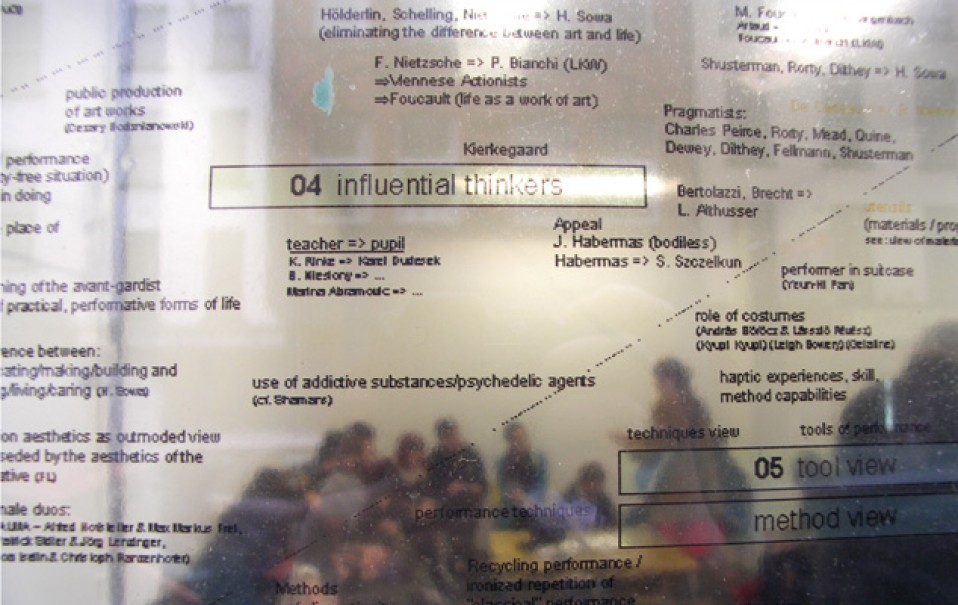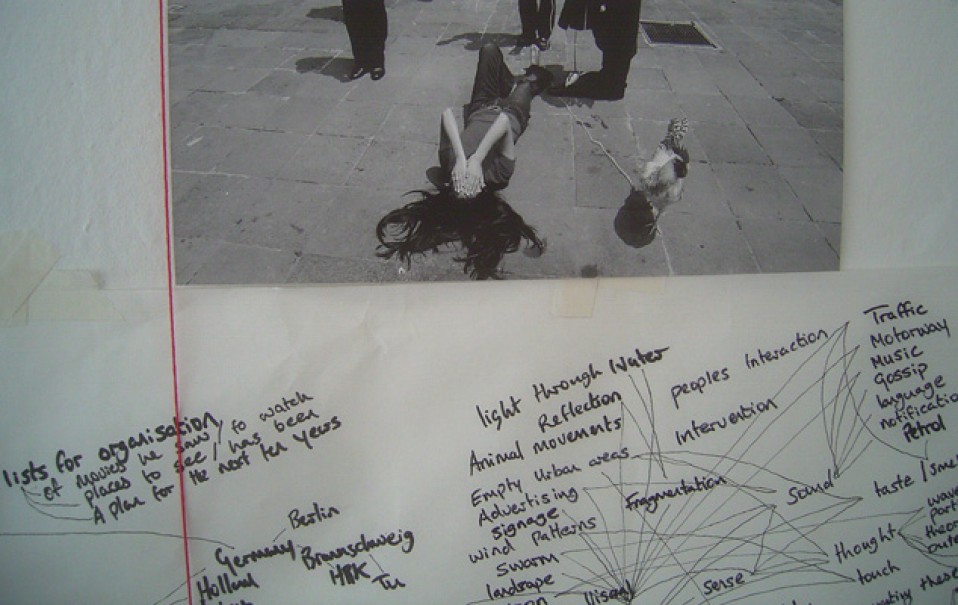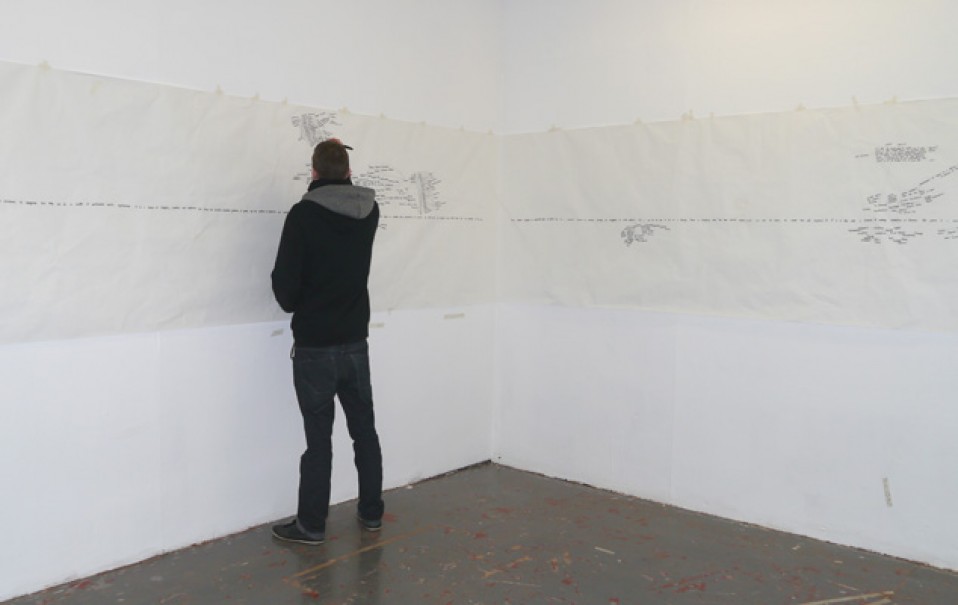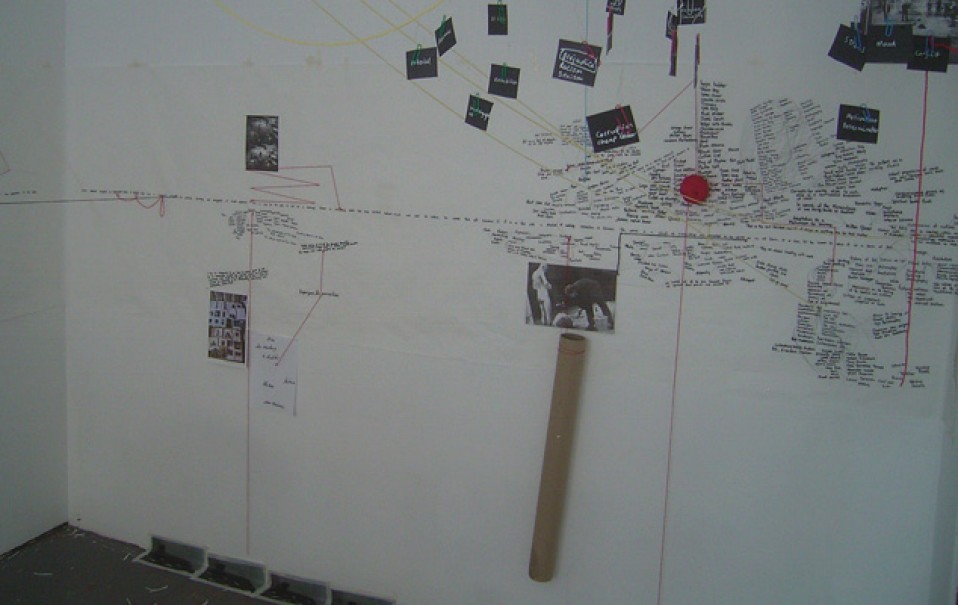
Mapping 'Performance Art in Context'
A map work by Boris Nieslony and Gerhard Dirmoser
Boris Nieslony, Gerhard Dirmoser, curated by Sinead O'Donnell
Ends 24 March 2012
Part 1: 17 February - 03 March 2012
Part 2: 12- 24 March 2012
Time table of events / times/locations
17 - 29 February @ PS²
University of Ulster Students on the ‘BA Fine and Applied Art’ are occupying PS² and will respond to the mapping work of Boris Nieslony. They will investigate their own concepts and manifestations of how to build a mapping system within their professional practices. The university course focuses each Friday on a studio seminar, involving a range of experiments, visits, projects, screenings, performance mornings and other explorations of contemporary art practice. In this case it has been an extended invite for the students to expand on the idea of mapping while the 'Performance Art in Context map' is live in the space.
Thursday 01 March @ Arts & Disability Forum, 109-111 Royal Avenue, 12am – 2pm: ADF 'conversation series': Sinéad O’Donnell & Boris Nieslony.
The Arts & Disability Forum is a disabled-led development agency working towards cultural equity; delivering a cross-border arts grant scheme alongside a range of challenging and innovative exhibitions, and events, plus access, education and inclusion activity - Please contact the ADF for further information and access requirements.
Thursday 01 March @ PS², 6pm -9pm (Late Night Art)
Boris Nieslony – Performance
Friday, 02 March, 10.30am- 12.30pm @ PS²
Boris Nieslony & ‘STVP’
University of Ulster art students will stage a work session.
Saturday, 03 March: 11.30 am @ PS²
bbeyond
Boris Nieslony and guest Peruvian USA based performance artist Mariel Carranza will lead a bbeyond monthly performance art meeting in Belfast. Admission to all events is free of charge and everyone is welcome.

22 February/ 02 March 2012: Christopher Cambell/ Boris Nieslony- responses

Responses- installation view
This project, curated by Sinéad O’Donnell, investigates an existing A0 size map by the German performance artist Boris Nieslony and Gerhard Dirmoser. It is titled ‘Mapping’ Performance Art in Context’ and was researched and finally produced over a period of fifteen years. The map describes the layered categorisations, disciplines, methodologies and locations of Nieslony’s research toward the origin and definition of performance art. As part of a process of opening up this unique mapping system, the map will be viewable on the project space window.
Boris Nieslony has worked intensively as a performance artist, curator, archivist and independent scholar, staging installations, interventions and artist projects since the 1970s. The founder of Black Market International, a performance group that meets regularly in various configurations to realise group performance projects, Nieslony is also the instigator of the ASA foundation, the platform for a self-organising a rhizomatic network of performance artists and theorists. The artist is recognised as one of performance art’s most prolific and significant contributors, creating unpredictable and unrepeatable improvised performance works that manifest “an encounter and its effects”. Responding to local circumstances, he develops images attuned to the moment, rigorously searching for the truth of self-recognition at the intersection of history and live presence. His impressive performance style stems from the motto “life is art enough”.

17 February 2012: mapping session with students

22 February 2012: Christopher Cambell - response to the mapping work of Boris Nieslony and Gerhard Dirmoser
Artist and curator Sinéad O'Donnell explains her intention
'I wrote to Boris to say that although the map provides a huge landscape of information for the artist, performance artist and researcher, in terms of access, it's just not accessible. So I asked Boris if he would consider allowing me to expose his map and open it up in terms of access and communication. Not everyone has the ability to read this format of mapping, let alone understand an art form that is very young, quite abstract, interior in meaning, time-based and ephemeral. It is an art form that is very much about presence and energy and I want to share this excitement with a wider audience'.
This project was developed as part of the ‘curator in residence' project’ in PS², 2011 and selected for realization.
See also Ben Crother's: The New Adventures of a Wonder Woman.
Image top: Section of Mapping 'Performance Art in Context'; a map work by Boris Nieslony and Gerhard Dirmoser.
To read a review by Louise Younger about the project see visualbelfast.
THE CULTURE OF PERFORMANCE, PERFORMANCE- and PERFORMING ARTS

The idea of the diagram
• The basic form was founded in the image of an eye. An eye as a mirror, as a theatre of sense, as a theatre of science as well.
• The theory of vision, the range ray of sight from inside to outside and flowing back
• The theory of time. Each movement has his own way in time and space. Its not a question of cultural representation. There are still a lot of different movements in acting. ( George Kubler: Shape of Time).
• The “Allotropy” – In the light of perception each acting grows up as an incomparable fact in the human being.
• In this case, ASA-European starts to find (all ? ) terms which people (artists, theorists) used to describe his / her activity as a cultural, ethnographical or anthropological setting in any kind of society.
We have some special views in the dates 1880 and 1948.
• To each term we have to collect texts and statements. As soon as possible we set up this archive under this web-address
The structure of the diagram
The are different ways to look on the context-eye-diagram. From the middle to the edge you have 3 steps and 4 fields. The first field in the centre is empty. In the basics the act is the act and not more. The act is whole, the universe, the entirety and doesn’t need any interpretation.
On the border of this emptiness begins the inquisitiveness of the intellect He wants to know what happens, what it means, this act is occupied by his observation. He can enter each of the 32 sights, which are defined in terms for the first steps.
The 32 sights (formed as triangle) are all modes which are used in the human world as any kind of methods, models of thinking, meaning, considerations, science and so on.
The first step is emotional, physical, psychological, the first view. The second step (third field) is more abstract and the last field points out the literature, theory, abstracts, etc.
Detail: Boris Nieslony and Gerhard Dirmoser.

Detail: Boris Nieslony and Gerhard Dirmoser
The goal
The diagram shows the difficulty in setting up basic rules in view of the question what performance is at all. 1st aim is to break the hierarchy of iconology, to break the hegemony of the “variability of the same”, to break the one-dimensional cultural views and to open the richness in the difference of human acts.
Beneath this two kind of aspects of the structure we had include the terms (definitions), the names/concepts of hundreds of artists and theorists and some short paraphrases of the terms. To set up this names, terms, sights and steps builds up a complex field of relations and contexts. It builds up an overview which allows to understand how performance and performing arts develop any relations, networks, main- and by- and sideways.
Further on, the context-diagram enables to research the development of terms, the history of the ideas, the marking of key-emotions.
For example the activities in the field “Agit-Prop”. Founded in the time of Russian revolution, the idea influenced the theatre of Bert Brecht, later the worker-theatres in USA in the thirties, from there, the idea returns to Europe, used by the Situationistic Internationale and the Lettrists, had some influence onto the political actions 1968 in Germany and (more and longer in France), was used as a title for an exhibition by the early video artists from Germany and Canada in Banff / Canada (1981) and got some new sense in the nineties last century for example in such activities like “Büro Bert”.
This kind of research opens directions to perceive, to reflect, to see and hear, how the things going on and how they inter-act. We had found in the meantime around 140 terms like this.
Nothing is really new. Anything has his relation, influence and is part of the known or unknown context. Nobody knows the margins of this interdependecies – an the weaving on this net.
Such a context is always a diffusion or a fogchamber. As a frame of construction as well. It makes visible what under the viewmode of a linear VIP representation and anecdotes by university disciplines must be unvisible. A kind of paradigm turn.
To keep pace with this growing, net and research we create the
E.P.I. Zentrum (European Performance Institute)
The E.P.I.-Zentrum is generally a nomadic and only temporary localised project. The cooperative artists, organizations, sponsors and other supporters come ad hoc together for researches and will connect their special projects in any way with their own or other institutions (universities, academies of arts, artistic or scientific projects etc.) In the beginning the preparatory committees are:
a) the two basic secretaries: ASA-European e.V. (Cologne / Frankfurt a.M.) and
Maschinenhaus Essen / Zeche Karl (Essen)
b) Black Market International
The E.P.I.-Zentrum is international, intercultural and works independent from academic departments and their traditional borderlines.
There is no legal membership, artists and organizations can work together temporary or for a long time with the nomadic Institute.
Aims
- New ways of information, discussion, research and the development of education and mediation in Performance Arts
- Transformations from the theoretical and practical understanding of “acting” and practice in to a general contextual, field-research-based and medial / mediated “practice of action” (research as acting)
- Performance as a wide and widen ethnographic and anthropological mode of perception and acting
- Performance as a critical social instrument
- Performance as a social organ of communication and exchange (“Die Gabe”/ “The Gift”)
- Performance as a life-based mode of orientation and contextual / social statement of interests (Performance as the aim of E.P.I.-Zentrum)
Basic Researches I
- Performance, Performance Arts and Performing Arts
Basic Researches II
- Performance as social acting and a mood of practice
Image-Research in both subjects
Gerhard Dirmoser / Boris Nieslony / ASA-European
The sights
Sichten II (zweite Schicht –
Ergänzungsschicht)
(zeitgeistiger u. etwas abstrakter als die erste Schicht)
Sichten I (erste Schicht – erster Ansatz)
Performance als ...
Theater als ...
Theoriebezüge
01 Kulturtheoretische Sicht
Kontextuelle Sicht
„Zwischenräume“
Performance als situative Produktion
Performance als situatives Experiment
Kulturtheorie
cultural studies
kontextbewußte Theorien
02 Entgrenzungssicht
Konzeptuelle Sicht
„Kunst ohne Personen“
Performance als offenes System
Performance als Übergangsform der Kunst
Das offene Kunstwerk
Spielregeln der Kunst
03 Interdisziplinaritätssicht
Sicht der künstlerischen Produktion
„Kollaborative Environments“
Performance als personales Experimentierfeld
performance theory
Erkenntnistheorie
04 Methodensicht
Werkzeugsicht
„künstlerische Metapraxis“
Dialogische Ansätze
05 Sicht der Innovation
Sicht der Kunstkritik
Performance als Profiliereinrichtung
Revolutionäre Performanceansätze
performance theory
06 Transportsicht
„Auflösung des Werks im Akt der Präsentation“
Vermittlungssicht
Sicht der Vermittler
Performance als Medium der Kunstvermittlung
Kommunikationstheorie
Spielregeln der Kunst
07 Subversionssicht
Medienkritische Sicht
„Underground City Utopie“
Sicht der Medien
(intermediale Ansätze)
„Oral, multimedial“ (1)
Performance als Kommunikationsguerilla
Kommuikationskonzepte der Performance
„it´s all about communication“
Medientheorie
Medienwissenschaften
Kommunikationstheorie
Informationstheorie
08 Psychoanalytische Sicht
Körpersicht
Gustative Sicht (Geschmack; einverleibend)
Performance als Leistung
Psychoanalyse /
queer theory / gender studies / body theory / Körperphilosophie / Körpersoziologie / Tanztheorie / Ekeltheorie / Phänomenologie der Wahrnehmung
09 Identitätssicht
Alltagssicht
„Lebenskunstwerk“
„Life ist art enough“
“Kunst als Lebensform”
Performance als Praxis der Artikulation von Identität
Performance als Leben
Performance als Aufenthaltsort
Performance als „Übersetzung“
Soziologie (Bourdieu)
cultural studies
Lebensphilosophie
Spielregeln der Kunst
10 Emotionale Sicht
„Emotions“
Rezipientensicht
Taktile Sicht
„sympathische Vibrationen“
Performance als Handlung
Performance = Die Kunst des Handelns
Manifest des Taktilismus
Existentialismus (Primat des Handelns)
11 Feministische Sicht
Politische Sicht
Interkulturelle Sicht
„Absicht und Absichtslosigkeit“
Interkultureller Austausch in der Performance
Performance als politisches Phänomen
(Performance in der Politik)
Performance als Demonstration
Performance als Praxis der Destabilisierung
Performance als Kommunikationsguerilla s.o.
Kulturtheorie
feminist studies
gender studies
anthropology of gender
Kulturhistorik
Spielregeln der Kunst
12 Ethische Sicht
„sozial & minimal“
Ästhetische Sicht
Visuelle Sicht
„Ereignis und Aura“
Performance als Aufmerksamkeit
„performative turn“ im ästhetischen Dasein
Ästhetik
Kunsttheorie
Morphologie
Ekeltheorie
Kommunikationsästhetik
13 Intensitätssicht
„Energieverwandlungen“
„performative Kraft der Kunst“
...
14 Therapeutische Sicht
Sicht des Künstlers
Sicht der Künstlerin
Performance als gestalterisches Experimentierfeld
Performance als Handlungsform in der therapeutischen Praxis
Performance als Katharsis
Performance = bewußtes Träumen
Gestalttherapie
Psychodrama
Psychotechniken
Urschreitherapie
Systemtheorie
Tanztheorie
15 Erkenntnistheoretische
Sicht
„Kunst als Erkenntnissystem“
Sprachliche Sicht
Performance als Sprache
analytische Philosophie /
Rhetorik / Sprachwissenschaft /
Strukturalismus / Sprechakttheorie / Erkenntnistheorie
16 Sicht der Oralität
„Oral, multimedial“ (2)
Performance als ureigenste menschliche Sprache
Performative Theorien / Rhetorik / Sprechakttheorie / Ethnologie
17 Existentielle Sicht
Sicht des Kunstwerks
„Vom Werkhaften zum Performativen“
Performance als Werk
„Kunst ohne Werk“ (1)
Bildtheorien
18 Sicht der Zerstörung
...
Performance als Praxis der Destabilisierung s.o.
Destruktionskunst (Buch)
19 Sicht der Repräsentation
Materiale Sicht
olfaktive Sicht (Geruch)
Performance als Ablagerung
Performance als Materialsammlung
Performance als bilderzeugende Handlung
Performance als Gegenkonzept zur “Repräsentation“ „Kunst ohne Werk“ (2)
Performative Skulpturen
Kunsttheorie
20 Unterhaltungssicht
Sicht des Marktes
Performance als Leistungsschau
Medientheorie
21 Ökonomische Sicht
Produktsicht
Finanzierungssicht
Kostensicht
Sponsorensicht
Modeschau als Performance (u.u.) (@HOME)
Performance als Show
Performance als Ereignis
Spielregeln der Kunst
22 Machttheoretische Sicht
„Ereignen zw. Herrschaft u. Begegnen-lassen“
Sicht der organisierenden Institution
Die permanente Performance
Machttheorien
Spielregeln der Kunst
23 Historische Sicht
Sicht der Sammlung
Performance als Relikt
Performance als Wandzeitung
Performance als ständige Sammlung
Performance als „totale“ Installation
Performance als Installation
Kunsthistorik
Kulturhistorik
24 Strukturelle Sicht
Strukturale Sicht
Sicht der Partitur
Performance als Zeichensystem
„Kollaborative Environments“ (1)
Strukturalismus / Semiotik /
Systemtheorie
25 Akustische „Sicht“
räumliche Sicht
(architektonische Sicht)
„Der Ort und das Werk“
„Der Ort als Performance“
Performance als ortlose Kunst
Architekturdekonstruktion als Performance
Performance als Vereinbarung
Die verborgene Performance
Musiktheorie
Wahrnehmungstheorien zur Architektur (B. Leitner)
26 Bewegungssicht
Zeitliche Sicht
„100 Momente ergeben eine Momenttheorie“
Performance als Inszenierung
Tanztheorie
Filmtheorie
Dromologie
27 Pragmatistische Sicht
Prozeßsicht
Performance als Prozeß
Pragmatismus
28 Performativität als Sicht
...
„performative turn“ im ästhetischen Dasein
„Vom Werkhaften zum Performativen“
Performative Theorien
Sprechakttheorie
feministische Theorien (J. Butler)
29 Soziologische Sicht
Anthropologische Sicht
Ethnologische Sicht
Rollensicht
„Anthropologie in Aktion“
„Tod als Performance“
Performance als gesellschaftlich geprägtes Rollenspiel
Performance als soziale Praxis
Performance als Ritual
Performance als Mimesis
Anthropologie / Ethnologie / Theologie / Theateranthropologie / Ethnographie /
Kulturanthropologie /
Spielregeln der Kunst
30 Philosophische Sicht
Sicht der Kunstwissenschaft
Sicht der Theaterwissenschaft
Performance als Sachverhaltsdarstellung
Performance als Theater
Theatertheorie
31 Magische Sicht
„Höhere Wesen“
Performance als Ritual s.o.
Alchemie
„Manifest Jean Odermatt“
32 Mythologische Sicht
Inhaltliche Sicht
Peformance als Erinnerungstheater
Kulturanthropologie

